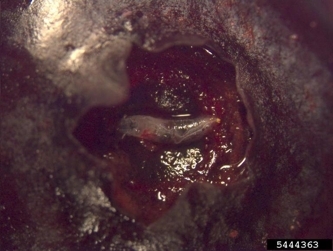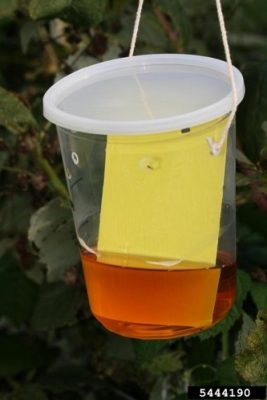Drosophila suzukii
The spotted wing drosophila is an invasive vinegar/fruit fly. The SWD originated in East Asia and has been in Hawaii since the 1980s, in California since 2008, and was first found in Connecticut in 2011. The SWD is believed to be widely dispersed throughout North America. An insect of significant concern to commercial and home gardeners, the SWD, unlike other fruit flies that prefer rotting or fermenting fruit, will lay its eggs in just-ripening, soft-skinned fruits such as blackberry, blueberry, cherry, raspberry, and strawberry. It will occasionally infest other fruits such as apples, grapes, mulberry, peaches, persimmons, plums, plumcots, nectarines, and figs if the proper conditions exist.
Identification and Life Cycle
The spotted wing drosophila adults and larvae resemble the common vinegar fly, Drosophila melanogaster, and other Drosophila sp. The adults are small, 1/16th to 1/8th” in length, with a light brown body (thorax) with black stripes on the abdomen and red eyes. Males have a black spot near the tips of their wings and two small dark bands on their front legs. Females do not possess spots on their wings but can be distinguished by their serrated or saw-like ovipositor (a tubular organ through which a female insect deposits eggs). It is this strong ovipositor that allows it to pierce ripening fruit.

SWD larvae are tiny, white, cylindrical maggots, up to ¼” long that can be found feeding within fruit. Once they have matured the larvae may pupate inside the fruit or leave the fruit to pupate in the soil.

The SWD has a life cycle of 14–21 days. In this time the SWD egg progresses through its larval stage, pupates and matures into an adult. The female will lay 1-3 eggs per insertion with an estimated total of 300-400 eggs over the course of her lifespan.
Control
Home gardeners may not see fruit flies in and around their plants but will notice the larvae in the harvested fruit. There are basically four ways by which a gardener can determine whether or not the SWD is present in their garden:
- Swarms of fruit flies in and about their plantings.
- Larvae present in the harvested fruit.
- Brown or sunken spots in smooth-skinned, ripening fruit where females have laid their eggs.
- Sites where the eggs have hatched will be soft and sunken as the larvae begin to eat the interior fruit flesh.
Traps
- Traps are an indicator of the presence of the SWD, not a control measure although any captured adult females will not be able to produce additional eggs. Other fruit flies will also be attracted to it.
- Traps can be made using lidded, plastic containers.
- Black or red plastic are most attractive to the SWD.
- Drill small holes in the sides.
- Bait the trap with apple cider vinegar or sugar water with a small amount of dish soap added to it. A combination of water, sugar, yeast, and whole wheat bread is also attractive (don’t forget the dish soap which reduces the surface tension of the liquid).
- Change the bait weekly.
- A yellow sticky card (optional) can aid in the capture of the SWD.
- Traps should be monitored regularly.
- One trap can service an acre and should be enough for most home plantings.

Sanitation
Sanitation is an important control measure. Clean up, remove and bag all infected fruit and do not compost it. Pick fruit as it ripens and do not leave over-ripe fruit on bushes.
Netting
Netting with a 0.039 inch (.98 mm) grid size mesh may provide control but this may also reduce air circulation around the plants.
Biological/Chemical
Insecticides should be chosen based on their registration for use on food crops and their pre-harvest interval, that is, the number of days between spraying and the harvesting of fruit. Many of the host plants for SWD may have ripening fruit while the plant is still in flower so that insecticides that will affect pollinators should be limited to application very early in the day or at dusk.
Despite good cultural practices, pests and diseases at times may appear. Chemical control should be used only after all other methods have failed. For pesticide information or other questions please call toll free: 877-486-6271.
UConn Home and Garden Education Center, 2019